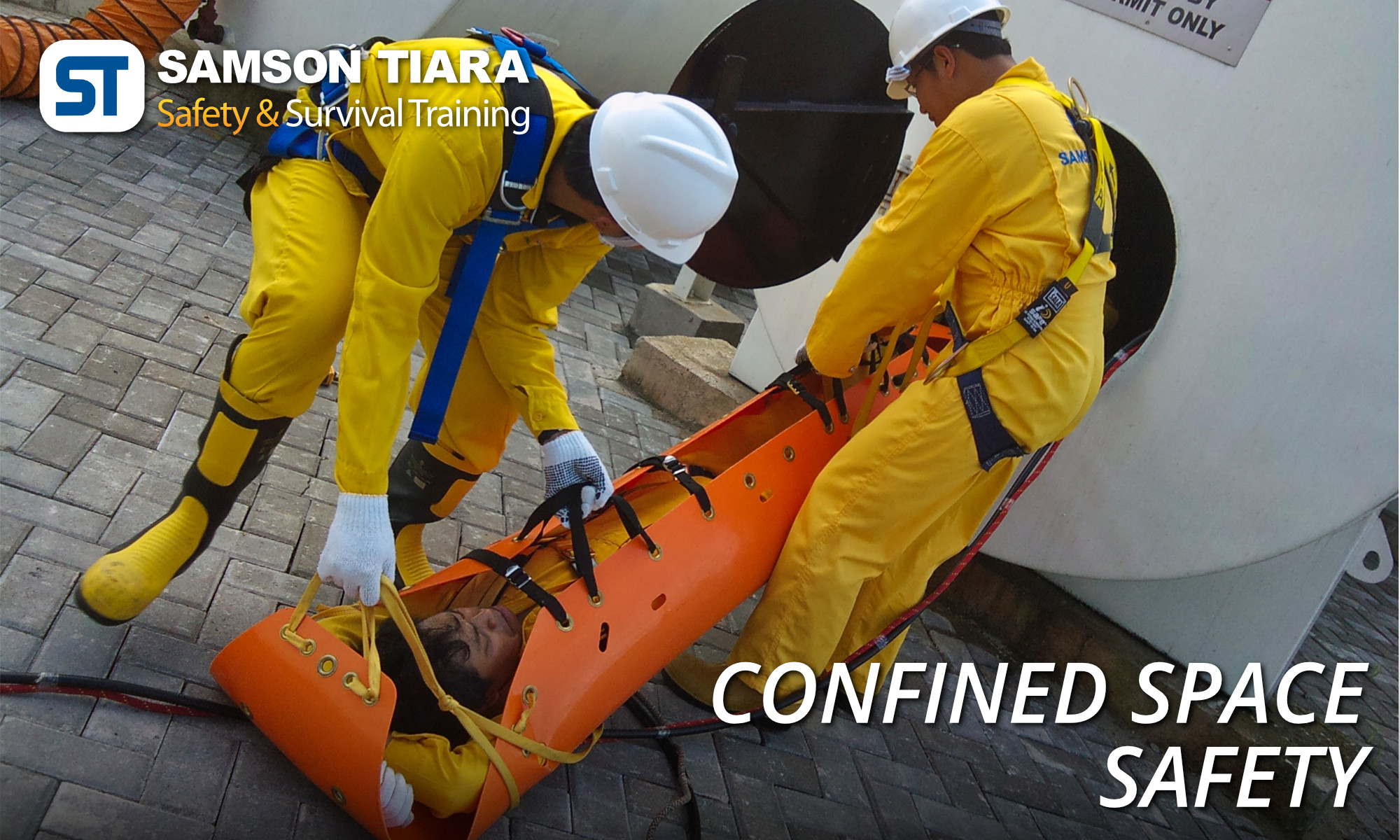A confined space is typically defined as a space that is not designed for continuous occupancy and is difficult to enter and exit. They are typically small, enclosed areas with limited ventilation, making them hazardous to workers. Some examples of confined spaces include tanks, pits, chimneys, silos, underground sewers, pipelines, tunnels, wells, and storage bins. Confined spaces may have only one entry or exit point and may pose numerous risks to people working in these environments.
It is of vital importance that those working in confined space environments have a thorough understanding of the associated hazards and safety measures to mitigate those hazards.
-
-
- Lack of oxygen: Confined spaces often have limited ventilation, which can cause a decrease in oxygen levels. This can potentially lead to breathing difficulties, fainting, and, in serious cases, death.
- Toxic or flammable gases: Confined spaces can contain hazardous gases, such as methane, carbon monoxide, or hydrogen sulphide, with some carrying the potential to ignite, while others can cause poisoning.
- Physical hazards: Confined spaces are, by the very nature of their name, cramped, with limited space to move. This hazard increases the risk of slips, trips, and falls, as well as bruises, cuts, and other injuries.
- Entrapment or engulfment: Workers may become trapped or engulfed in confined spaces, leading to suffocation or other injuries.
- Heat stress: Confined spaces are often hot and humid, which can potentially lead to heat exhaustion or heat stroke.
- Communication difficulties: Communication can be difficult in a confined space; this can lead to misunderstandings and accidents.
-
Due to these hazards, carrying out a rescue in a confined space is often very difficult, with many of the reported casualties of confined space work resulting from attempts to rescue workers in distress. As such, avoiding the need for any such rescue by following the correct procedures and using the correct equipment is paramount.
Safety Procedures
To ensure the safety of workers in a confined space environment the following safety procedure should be followed at all times:
Risk Assessment
Prior to any confined space entry, a thorough risk assessment should be conducted to identify the hazards present in the confined space and the appropriate measures to control those hazards.
Entry Permit System
Before workers are allowed to enter the confined space, an entry permit system should be in place. This permit should include a checklist of all the safety measures that must be taken prior to entry, such as testing the air quality, securing the space, and ensuring that communication equipment is in place.
Ventilation
Prior to entry, ventilation equipment, such as blowers and fans, should be set up to properly ventilate the space to help ensure the air in the confined space is safe to breathe. The appropriate type and method of ventilation should be identified in the Risk Assessment.
Atmosphere Testing
While it is imperative to test the quality of the air prior to entry, it is equally important to continuously monitor the air quality in the confined space while workers are inside to check for potential hazards such as low oxygen levels, flammable gases, or toxic vapours. Early detection of changes in the atmosphere can buy precious time to increase the ventilation or evacuate the space, reducing the risk of injury or death.
Personal Protective Equipment (PPE)
Workers entering the confined space should always use the appropriate PPE, such as respirators, gloves, and protective clothing, to help protect themselves from hazards.
Lighting
It is important to provide adequate lighting inside the confined space to enable workers to see potential hazards and navigate the space safely.
Rescue Plan
A detailed rescue plan should be in place prior to any confined space work and it is of vital importance that everyone involved in the confined space entry be trained on that rescue plan. As previously stated, many of the casualties from confined space work are workers attempting to rescue incapacitated colleagues, therefore it is important that only those who have undergone rescue training involve themselves in rescue efforts.
Communication
Establish clear communication procedures between workers both inside and outside the confined space to ensure that workers can be monitored and supported at all times.
Personal Protective Equipment (PPE)
As mentioned above, it is important for all workers in confined space to wear the appropriate PPE which may vary depending on the specific hazards present in the space and the job requirements. Some of the most common types of equipment and PPE that may be necessary for safe confined space entry include:
Harnesses and Lifelines
These are used to prevent falls and to enable the rescue of workers in case of an accident. The harness should be properly fitted to the worker and attached to a secure anchorage point, and the lifeline should be of sufficient strength and length to enable rescue if needed.
Gas Detectors
These are used to detect hazardous gases and vapours, such as oxygen deficiency or toxic gases. Workers should use a calibrated gas detector to test the air quality of the confined space before entry.
Respirators
Respirators are necessary if there is a risk of inhaling hazardous gases, dusts, or vapours. The type of respirator needed will depend on the specific hazard and should be selected according to relevant HSE regulations and guidelines.
Protective Clothing
Workers may need to wear protective clothing such as coveralls or chemical-resistant suits to protect against hazardous substances. Head protection, such as a hardhat or other appropriate helmet should be worn at all times to protect the worker from injury due to impact with low ceilings or overhangs. If a worker may be required to crawl on hands and knees within the confined space, knee protection is also suggested.
Lighting
Adequate lighting is essential for safe work in a confined space, as it helps workers see potential hazards and navigate the space safely. While area lights offer the best illumination, these are not always possible, therefore personal lighting, such as hard hat or harness mounted lights should be available to all workers.
Communication Equipment
Workers inside the confined space should be equipped with communication devices such as radios, so they can communicate with those outside the space in case of an emergency. Prior to entry batteries should be checked to ensure full charge and radios should be tested for proper functionality.
Training
It is critical for workers to understand the risks associated with confined space work and to know how to work safely in these environments. Overall, training for confined space entry is critical to ensuring the safety of workers who are required to work in these areas. Workers who are properly trained are better equipped to recognize hazards, use the proper equipment and PPE, follow established safety procedures, and respond appropriately in case of an emergency.
PT Samson Tiara offers a range of confined space training programmes, accredited both locally and internationally, to help improve the safety of your workers.
Confined Space Entrant / Attendant
This intensive two day course is designed to provide workers and supervisors with knowledge and skills required when working in a confined space environment. The programme will cover hazards, equipment and procedures for working safely in a confined space environment. Trainees will acquire knowledge and skills through a combination of lecture presentations, group discussions, and through both individual and team practical exercises carried out in our simulated confined space environments.
More information on this course can be found here (https://www.samson-tiara.co.id/Course/Confined-Space-Entry/) or for TEEX certification here (https://www.samson-tiara.co.id/Course/Confined-Space-Safety-Entrant-Attendant/).
Confined Space Entry And Rescue
This intensive three day course is designed for those who may be required to participate in the rescue of an incapacitated worker from within a confined space. The course uses intensive training drills to give trainees the skills required to conduct confined space rescue safely and effectively.
The programme will review safe working procedures for confined spaces. Trainees will learn the knowledge and skills required when planning and executing rescues from a variety of confined space environments.
Knowledge and skills will be acquired through a combination of lecture presentations, demonstrations and both individual and team practical exercises. Trainees must successfully complete written and practical testing to receive course certification.
More information on this course can be found here (https://www.samson-tiara.co.id/Course/Confined-Space-Entry-Rescue/) or for TEEX certification here (https://www.samson-tiara.co.id/Course/Confined-Space-Safety-Entry-Rescue/).
About Samson Tiara
Samson Tiara is committed to serving both companies and individuals by providing the best safety and survival training that meets both international and local standards. Samson Tiara provides a wide range of training for oil and gas, petrochemical, manufacturing, offices, apartment buildings, malls and other facilities where disaster mitigation, firefighting and first aid are required.
Many of our courses are available on a weekly schedule with others available on request. We have entered into many strategic partnerships with OPITO, TEEX (Texas A&M Engineering Extension Service), Aberdeen Drilling International, Wild Geese Group, RelyOn Nutec Digital and others.
Samson Tiara’s industry leading offerings include:
-
-
- Accommodation and laundry (we cooperate with several hotels to provide accommodation)
- Transportation (pick-up point in Jakarta, training centre and hotel)
- All training materials, equipment and workbooks
- Toiletries
- World class training facilities
- Bilingual staff
- Lunch and snacks
-
If you or your company require training, want to discuss the courses that we offer, or would like to register for a course, please contact the Samson Tiara Marketing Team at: marketing@survival-systems.com
Information about Samson Tiara: https://linktr.ee/samsontiara
#samsontiara #Firefighting #FireSafety #SafetyTraining #SurvivalTraining #safety #survival #training #education #oil #gas #emergency #offshore #onshore #rescue #digital #online #elearning #disaster #aid #security










